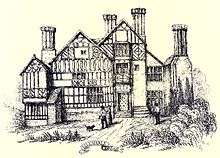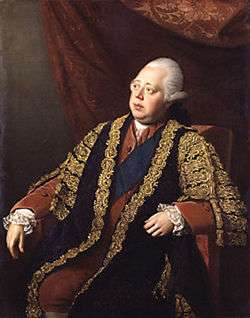Granville Leveson-Gower, 1st Marquess of Stafford
Granville Leveson-Gower, 1st Marquess of Stafford, PC (4 August 1721 – 26 October 1803), known as Viscount Trentham from 1746 to 1754 and as The Earl Gower from 1754 to 1786, was a British politician from the Leveson-Gower family.
The Marquess of Stafford PC | |
|---|---|
 | |
| Lord Privy Seal | |
| In office 1755–1757 | |
| Monarch | George II |
| Prime Minister | The Duke of Newcastle The Duke of Devonshire |
| Preceded by | The Duke of Marlborough |
| Succeeded by | The Earl Temple |
| In office 1784–1794 | |
| Monarch | George III |
| Prime Minister | William Pitt the Younger |
| Preceded by | The Duke of Rutland |
| Succeeded by | The Earl Spencer |
| Lord President of the Council | |
| In office 22 December 1767 – 24 November 1779 | |
| Monarch | George III |
| Prime Minister | The Earl of Chatham The Duke of Grafton Lord North |
| Preceded by | The Earl of Northington |
| Succeeded by | The Earl Bathurst |
| In office 19 December 1783 – 1 December 1784 | |
| Monarch | George III |
| Prime Minister | William Pitt the Younger |
| Preceded by | The Viscount Stormont |
| Succeeded by | The Lord Camden |
| Personal details | |
| Born | 4 August 1721 |
| Died | 26 October 1803 (aged 82) Trentham Hall, Staffordshire |
| Nationality | British |
| Political party | Tory |
| Spouse(s) | (1) Elizabeth Fazakerley (d. 1746) (2) Lady Louisa Egerton (d. 1761) (3) Lady Susanna Stewart (d. 1805) |
| Children |
|
| Parents | John Leveson-Gower, 1st Earl Gower Lady Evelyn Pierrepont |
| Alma mater | Christ Church, Oxford |
Background
Stafford was a son of John Leveson-Gower, 1st Earl Gower (1694–1754) and his wife Lady Evelyn Pierrepont. His maternal grandparents were Evelyn Pierrepont, 1st Duke of Kingston-upon-Hull and his first wife Lady Mary Feilding. Mary was a daughter of William Feilding, 3rd Earl of Denbigh and his wife Mary King. His father was a prominent Tory politician who became the first major Tory to enter government since the succession of George I of Great Britain, joining the administration of John Carteret, 2nd Earl Granville in 1742. Gower was educated at Westminster School and Christ Church, Oxford.[1]


Political and industrial investment career
Stafford was elected to parliament in 1744. With the death of his elder brother in 1746, he became known by the courtesy title of Viscount Trentham until he succeeded his father as Earl Gower in 1754. He built the earlier Lilleshall Hall, converting a 17th-century house located in the village of Lilleshall into a country residence around the late 1750s.
Stafford was associated with the faction of the John Russell, Duke of Bedford, who was his brother-in-law, and as a member of that faction, called the "Bloomsbury Gang", was given many governmental positions. Following Bedford's death in 1771, Gower became leader of the group, and as Lord President in the administration of Frederick North, Lord North, he was a key supporter of a hard-line policy towards the American colonists. Between 1775–1778, Stafford proceeded to make substantial alterations to his home at Trentham Hall based on the designs by Henry Holland.
By 1779, Gower resigned from the cabinet being frustrated by what he saw as the North administration's inept handling of the American Revolutionary War. And when North resigned in March 1782, Gower was approached to form a ministry, but he refused, and he refused subsequent overtures from both Lord Shelburne and the Fox-North coalition to enter the government. Instead, he became a key figure in bringing about the fall of the Fox-North coalition, and was rewarded with the position of Lord President once again in the new administration of William Pitt the Younger. Although he soon exchanged this office for that of Lord Privy Seal, and gradually began to withdraw from public affairs, he remained a cabinet minister until his retirement later in 1794. He was elected F.S.A. on 28 April 1784. In 1786, he was created Marquess of Stafford as a reward for his services.[1]
In 1799 he (or his immediate family benefit trust) was estimated the fifth-wealthiest small family unit in Britain, owning £2.1M (equivalent to £207,800,000 in 2019), having assets in land, mining and arterial canal-toll rights having speculatively invested in the latter projects, much of which in Staffordshire's Black Country.[2]
He died at Trentham Hall, Staffordshire, on 26 October 1803.[1] He was the last surviving member of the Bloomsbury Gang.[3]
Marriages and children
Stafford married three times. He married firstly Elizabeth Fazakerley, daughter of Nicholas Fazakerley, in 1744. Elizabeth died of smallpox two years later. They had no children.
Stafford married secondly Lady Louisa Egerton, daughter of the Scroop Egerton, 1st Duke of Bridgewater, in 1748. She died in 1761. They were parents to four children:
- Lady Louisa Leveson-Gower (22 Oct 1749-29 July 1827). She married Sir Archibald MacDonald, 1st Baronet.
- Lady Margaret Caroline Leveson-Gower (02 Nov 1753-27 January 1824). She married Frederick Howard, 5th Earl of Carlisle and was the mother of George Howard, 6th Earl of Carlisle.
- George Leveson-Gower, 1st Duke of Sutherland (9 January 1758 – 19 July 1833).
- Lady Anne Leveson-Gower (22 Feb 1761-16 November 1832). She married the Right Reverend the Hon. Edward Venables-Vernon-Harcourt, Archbishop of York.
Stafford married thirdly Lady Susanna Stewart, daughter of Alexander Stewart, 6th Earl of Galloway, 23 May 1768. They were parents to four children:
- Lady Georgiana Augusta Leveson-Gower (13 Apr 1769 – 24 March 1806). She married William Eliot, 2nd Earl of St Germans.
- Lady Charlotte Sophia Leveson-Gower (11 Feb 1771; christened 12 Feb 1771 St Martin in the Fields, Westminster – 12 August 1854). She married Henry Somerset, 6th Duke of Beaufort and was mother of Henry Somerset, 7th Duke of Beaufort and Lord Granville Somerset.
- Lady Susanna Leveson-Gower (born Sep 1772; christened 15 Sep 1772 Trentham – 26 May 1838). She married Dudley Ryder, 1st Earl of Harrowby.
- Granville Leveson-Gower, 1st Earl Granville (born 12 October 1773, christened 5 Nov 1773 Trentham – 8 January 1846).
When Lord Stafford died at the age of 82, he was succeeded in his titles by his eldest son George from his second marriage who was created Duke of Sutherland in 1833. The Marchioness of Stafford died in August 1805.[1]
References
- Barker 1893.
- "Who wants to be a millionaire?", The Guardian, feature, 29 Sep 1999 https://www.theguardian.com/theguardian/1999/sep/29/features11.g2
- Chisholm, Hugh, ed. (1911). . Encyclopædia Britannica. 25 (11th ed.). Cambridge University Press. p. 756.
- Attribution
![]()
External links
| Parliament of Great Britain | ||
|---|---|---|
| Preceded by Marquess of Carnarvon Andrew Hill |
Member of Parliament for Bishop's Castle 1744–1747 With: Andrew Hill |
Succeeded by Samuel Child John Lytton |
| Preceded by Viscount Perceval Charles Edwin |
Member of Parliament for Westminster 1747–1754 With: Sir Peter Warren 1747–53 Edward Cornwallis 1753–54 |
Succeeded by Sir John Crosse Edward Cornwallis |
| Preceded by Henry Vernon Thomas Anson |
Member of Parliament for Lichfield 1754 With: Thomas Anson |
Succeeded by Henry Vernon Thomas Anson |
| Political offices | ||
| Preceded by The 3rd Duke of Marlborough |
Lord Privy Seal 1755–1757 |
Succeeded by The Earl Temple |
| Preceded by The Duke of Dorset |
Master of the Horse 1757–1760 |
Succeeded by The Earl of Huntingdon |
| Preceded by The 4th Duke of Marlborough |
Lord Chamberlain 1763–1765 |
Succeeded by The Duke of Portland |
| Preceded by The Earl of Northington |
Lord President of the Council 1767–1779 |
Succeeded by The Earl Bathurst |
| Preceded by The Viscount Stormont |
Lord President of the Council 1783–1784 |
Succeeded by The Lord Camden |
| Preceded by The Duke of Rutland |
Lord Privy Seal 1784–1794 |
Succeeded by The Earl Spencer |
| Court offices | ||
| Preceded by Sir Thomas Robinson |
Master of the Great Wardrobe 1760–1763 |
Succeeded by The Lord Le Despencer |
| Honorary titles | ||
| Preceded by The Earl Gower |
Lord Lieutenant and Custos Rotulorum of Staffordshire 1755–1799 |
Succeeded by Earl Gower |
| Preceded by The Marquess of Downshire |
Senior Privy Counsellor 1793–1803 |
Succeeded by The Marquess Townshend |
| Peerage of Great Britain | ||
| New creation | Marquess of Stafford 1786–1803 |
Succeeded by George Leveson-Gower |
| Preceded by John Leveson-Gower |
Earl Gower 1754–1803 | |
| Peerage of England | ||
| Preceded by John Leveson-Gower |
Baron Gower 1754–1799 |
Succeeded by George Leveson-Gower |
